Writing on Green
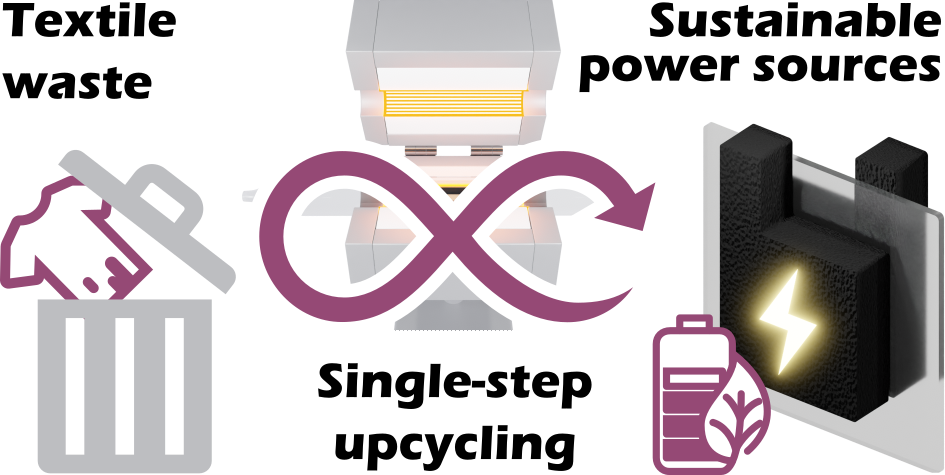
C. Tortosa, M. Navarro-Segarra, P. Guerrero, K. de la Caba, J.P. Esquivel
Sustainable Energy & Fuels 8 (2024) 3844-3853
Featured in journal front cover
Environmental impacts from the fashion industry are at the top of global pollution. Fiber production, fabric preparation and distribution, and disposal of textiles combined with the excessive consumerism of clothing result in the wastage of thousands of million cubic meters of fresh water, the release of gigatons of CO2 equivalent, and tens of millions of metric tons of textile waste generation every year. This situation shows that there is an urgent and mandatory need to change the fashion paradigm, but, even if accomplished, the current textile waste spread worldwide still needs to be managed in an environmentally conscious way. Upcycling textile waste by pyrolysis is gaining interest as an alternative management option. The goal is to endow waste with new functionalities for its repurposing into new applications. This study focuses on applying pyrolysis to convert discarded clothing into a conductive carbon textile while avoiding treatments with hazardous chemicals. Envisioned to be applied for current collection in all-organic primary power sources, the ultimate goal is to replace synthetic polymers in commercial carbon current collectors. Actual textile waste has been successfully pyrolyzed without the need for pre-treatments or activation. The structural composition of the samples was studied by SEM, X-ray diffraction, Raman spectroscopy, ATR-FTIR spectroscopy, EDS and BET surface area. Electrical and electrochemical characterization showed their suitability as current collectors, which was demonstrated by building an aqueous metal-free organic primary battery. A system of innocuous quinone-based redox chemistry coupled with the revalorized collectors delivered 11.17 mA cm−2 and 1.4 mW cm−2 of power density, proving the feasibility of the proposed application.

M. Navarro-Segarra, O. A. Ibrahim, I. Martin-Fernandez, C. Tortosa, J. M. Ormaetxea, M. Baumann, M. Weil, J. P. Esquivel
Energy & Environmental Science 17 (2024) 5639-5652
Internet-of-Things (IoT) is considered one of the primary enablers of the next digital transformation wave. Generating and exchanging data between the increasing number of delocalized sensors comes with the need for high-performance portable power sources that also meet environmental and social responsibility standards. This article presents a portable power source to meet the energy requirements of IoT devices in the smart packaging sector that has been designed-by-purpose in an ecologically benign way since the early development stage. To minimize the environmental impact throughout its life cycle, the battery follows the value chain of paper and cardboard, from material sourcing to disposability. Naturally abundant materials, such as cellulose derivates and alginate biopolymers, are prioritized to create the separator and contain the redox species. Manufacturing techniques, easily implementable in the packaging industry, are used to fabricate an adhesive label-like battery (based on layered components) and engrave the current collectors, via laser-induced graphene. The prototype’s energy adaptation capability is demonstrated by directly powering two applications particularly appealing for smart packaging, i.e., a printed electrochromic display and a wireless tracker device. Once depleted, the battery is compatible with paper and cardboard recycling standardized processes. The reconceptualization of the whole battery life cycle leads to the generation of a disruptive power source concept that aims to be an enabler of a sustainable digitalization of society.
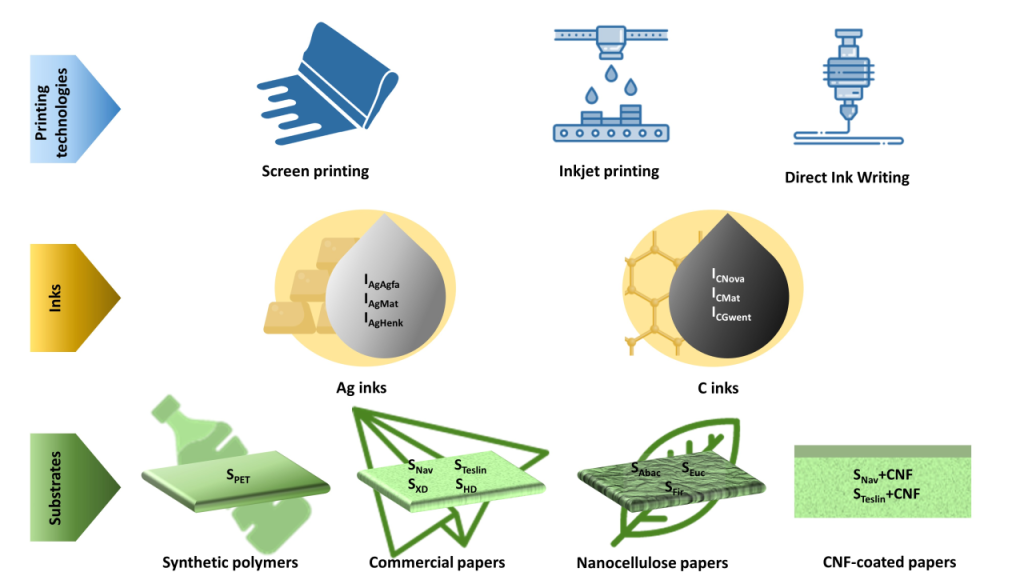
D. Batet, F. Vilaseca, E. Ramon, J.P. Esquivel, G. Gabriel
Flexible and Printed Electronics, 8 (2023) 024001
The selection of materials and technologies for green printed electronics design is a fundamental and time-consuming task. This paper represents a rigorous experimental overview in which different printing technologies, ink formulations, and paper-based substrates are examined and analyzed. Three printing techniques are investigated: inkjet printing, screen printing, and direct ink writing. Regarding the inks, formulations based on carbon and silver have been chosen as conductive materials. Initially, the electrical properties of the selected inks have been characterized on a conventional substrate in printed electronics such as polyethylene terephthalate. Later, the printing conditions are optimized for various paper-based substrates, including commercial papers and substrates based on cellulose nanofibers (CNF). CNF are also used as a coating for commercial papers and their influence on the printing quality is evaluated. The substrates are also characterized in terms of morphology, wettability, and thermal stability. This study facilitates the benchmarking tasks for researchers developing new devices and contributes toward the eco-design of flexible green printed electronics.
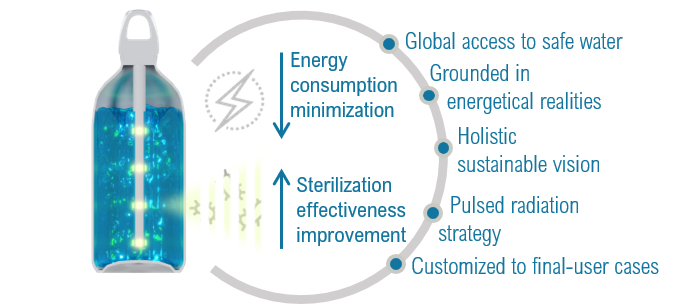
C. Ruiz-Díez, M. Navarro-Segarra, R. Barrena, T. Gea, J.P. Esquivel
Environmental Technology & Innovation 31 (2023) 103199
In many places of the world, the lack of municipal facilities for water sanitation and purification makes self-treatment at a familiar scale, the only realistic solution to ensure continuous access to drinking water. In this context, UV disinfection treatment is a portable and efficient alternative to conventional methods, however, its power need is hindering its implementation in remote off-grid households. This work presents a portable water sterilizer device using UV-C LEDs, conceived for its direct implementation in isolated rural communities. Pulsed radiation operation has been studied as strategy to reduce the device energy demand. Most relevant parameters affecting the device operation and performance, namely voltage, radiation time, frequency and duty cycle; are thoroughly studied using the Design of Experiments methodology to optimize energy consumption and Escherichia coli removal from polluted water. The optimal conditions, found for pulsed radiation, showed a noteworthy reduction of 68 % of the energy consumption while improving the sterilization effectiveness, compared with continuous radiation. Furthermore, the efficiency of sterilization of the optimized prototype was benchmarked against a commercial device using river water samples. The presented prototype achieved higher E. coli disinfection effectiveness using a fraction of the energy consumption. All in all, the presented water sterilization device is an example of a technological improvement which uses energy efficiency as key developing driver while achieving performance requirements. Thus, contributing to the creation of affordable and efficient technological solutions to promote global access to drinking water.
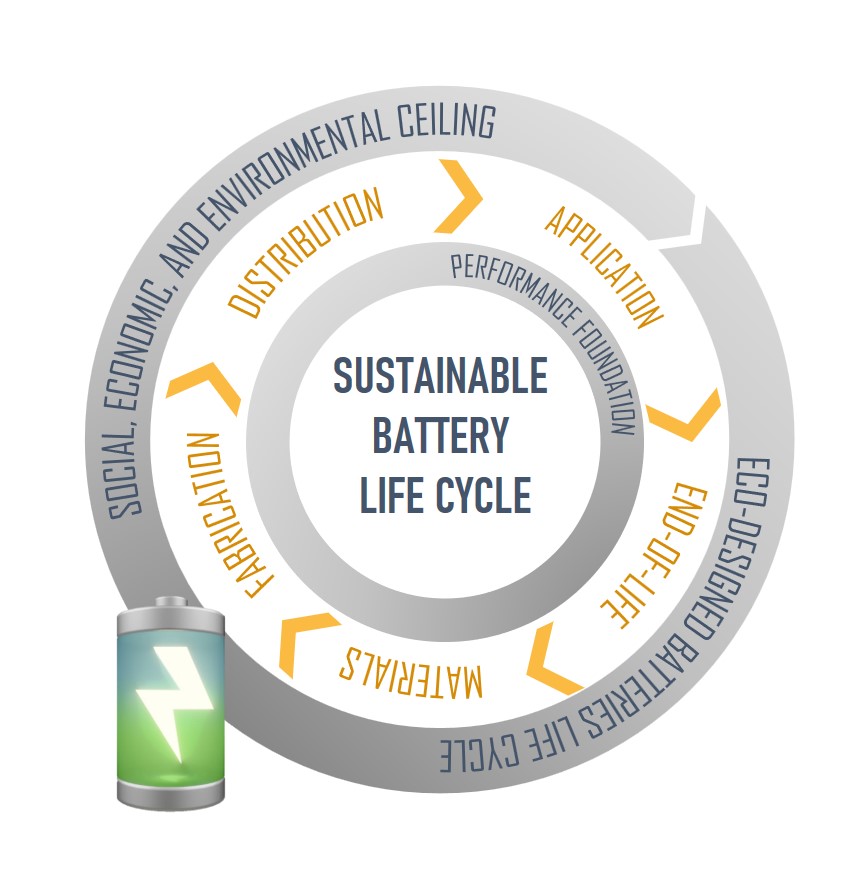
M. Navarro-Segarra & J.P. Esquivel
Sustainable Energy Storage in the Scope of Circular Economy: Advanced Materials and Device Design (Chapter 5)
The increasing demand for portable energy must be fulfilled by power sources with high performance, but that also possess environmental sustainability in terms of their materials, fabrication methods, and disposal. This chapter presents the state of the art of portable batteries with disruptive end-of-life and then proposes the portable battery development under a doughnut economics model perspective.
The rationale herein presented aims to change the current paradigm of portable batteries to a new model in which batteries are designed to follow the life cycle of the device to be powered, in order to minimize their environmental impact along their value chain. Using ecodesign as a fundamental tool, batteries’ life cycle stages are analyzed in detail and reformulated under a doughnut shape model that sets a social, economic, and environmental ceiling and a performance foundation. Under this frame, suggestions to be considered at each stage are proposed, e.g. raw material selection, manufacturing process, demanded energy capacity, operational time, and disposal considerations. In this sense, batteries made in compliance with alternative end-of-life scenarios, such as being capable to be biodegraded or even composted with other organic waste, are proposed as an alternative to minimize batteries’ impact on ecosystems.

M. Navarro-Segarra, C. Tortosa, C. Ruiz-Díez, D. Desmaële, T. Gea, R. Barrena, N. Sabaté, J.P. Esquivel
Energy & Environmental Science 15 (2022) 2900-2915
Featured in journal back cover
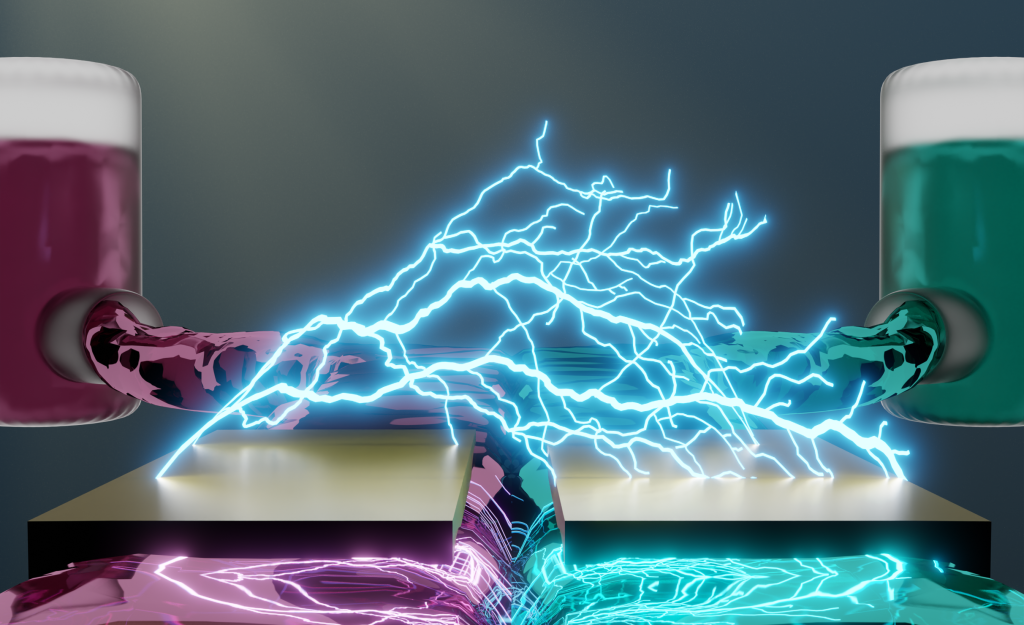
O. A. Ibrahim, M. Navarro-Segarra, P. Sadeghi, N. Sabaté, J.P. Esquivel, E. Kjeang
Chemical Reviews 122, 7 (2022) 7236-7266
Electrochemical energy conversion is an important supplement for storage and on-demand use of renewable energy. In this regard, microfluidics offers prospects to raise the efficiency and rate of electrochemical energy conversion through enhanced mass transport, flexible cell design, and ability to eliminate the physical ion-exchange membrane, an essential yet costly element in conventional electrochemical cells. Since the 2002 invention of the microfluidic fuel cell, the research field of microfluidics for electrochemical energy conversion has expanded into a great variety of cell designs, fabrication techniques, and device functions with a wide range of utility and applications. The present review aims to comprehensively synthesize the best practices in this field over the past 20 years. The underlying fundamentals and research methods are first summarized, followed by a complete assessment of all research contributions wherein microfluidics was proactively utilized to facilitate energy conversion in conjunction with electrochemical cells, such as fuel cells, flow batteries, electrolysis cells, hybrid cells, and photoelectrochemical cells. Moreover, emerging technologies and analytical tools enabled by microfluidics are also discussed. Lastly, opportunities for future research directions and technology advances are proposed.

